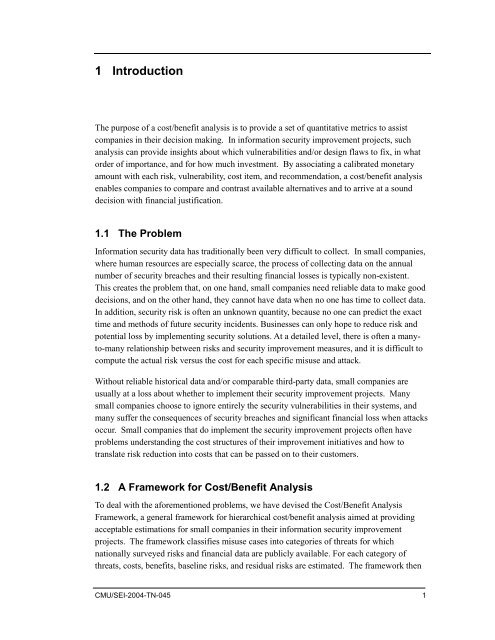SQUARE Project: Cost/Benefit Analysis Framework for Information ...
SQUARE Project: Cost/Benefit Analysis Framework for Information ...
SQUARE Project: Cost/Benefit Analysis Framework for Information ...
Create successful ePaper yourself
Turn your PDF publications into a flip-book with our unique Google optimized e-Paper software.
1 Introduction<br />
The purpose of a cost/benefit analysis is to provide a set of quantitative metrics to assist<br />
companies in their decision making. In in<strong>for</strong>mation security improvement projects, such<br />
analysis can provide insights about which vulnerabilities and/or design flaws to fix, in what<br />
order of importance, and <strong>for</strong> how much investment. By associating a calibrated monetary<br />
amount with each risk, vulnerability, cost item, and recommendation, a cost/benefit analysis<br />
enables companies to compare and contrast available alternatives and to arrive at a sound<br />
decision with financial justification.<br />
1.1 The Problem<br />
In<strong>for</strong>mation security data has traditionally been very difficult to collect. In small companies,<br />
where human resources are especially scarce, the process of collecting data on the annual<br />
number of security breaches and their resulting financial losses is typically non-existent.<br />
This creates the problem that, on one hand, small companies need reliable data to make good<br />
decisions, and on the other hand, they cannot have data when no one has time to collect data.<br />
In addition, security risk is often an unknown quantity, because no one can predict the exact<br />
time and methods of future security incidents. Businesses can only hope to reduce risk and<br />
potential loss by implementing security solutions. At a detailed level, there is often a manyto-many<br />
relationship between risks and security improvement measures, and it is difficult to<br />
compute the actual risk versus the cost <strong>for</strong> each specific misuse and attack.<br />
Without reliable historical data and/or comparable third-party data, small companies are<br />
usually at a loss about whether to implement their security improvement projects. Many<br />
small companies choose to ignore entirely the security vulnerabilities in their systems, and<br />
many suffer the consequences of security breaches and significant financial loss when attacks<br />
occur. Small companies that do implement the security improvement projects often have<br />
problems understanding the cost structures of their improvement initiatives and how to<br />
translate risk reduction into costs that can be passed on to their customers.<br />
1.2 A <strong>Framework</strong> <strong>for</strong> <strong>Cost</strong>/<strong>Benefit</strong> <strong>Analysis</strong><br />
To deal with the a<strong>for</strong>ementioned problems, we have devised the <strong>Cost</strong>/<strong>Benefit</strong> <strong>Analysis</strong><br />
<strong>Framework</strong>, a general framework <strong>for</strong> hierarchical cost/benefit analysis aimed at providing<br />
acceptable estimations <strong>for</strong> small companies in their in<strong>for</strong>mation security improvement<br />
projects. The framework classifies misuse cases into categories of threats <strong>for</strong> which<br />
nationally surveyed risks and financial data are publicly available. For each category of<br />
threats, costs, benefits, baseline risks, and residual risks are estimated. The framework then<br />
CMU/SEI-2004-TN-045 1
















